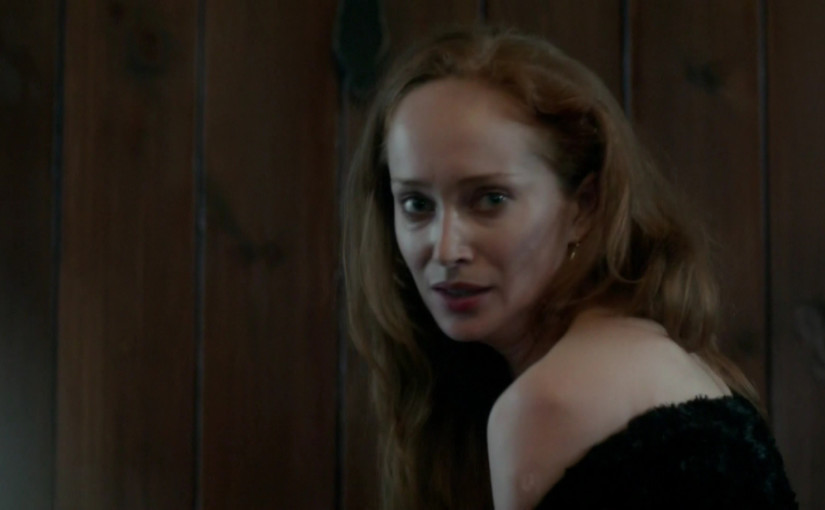Outlander’s Episode 111 – “The Devil’s Mark” – was intense to watch. It really made the viewers develop strong feelings about certain characters and actions. The acting was superb and very strong performances were given by Caitriona Balfe (Claire), Lotte Verbeek (Geillis) and Bill Paterson (Ned Gowan). First of all, this post contains SPOILERS, and it will be a long one.
In order to understand the witch trial better, one has to learn a little bit more about the set of traditions and customs engrained at that time and the way people used to think. “Logical” thinking is something very recent. The trend to think logically as it is done today started earlier but became more prominent in the 19th Century (Darwin’s theories probably being one of the main drives). In other words, the use of solid evidence to condemn somebody for a crime is something that started to be used recently.
Another concept that is worth mentioning is syncretism, the amalgamation of cultures and of course, religions. Basically when the Scottish Highlanders were christianized, the new teachings were based on their old Celtic faith and myths (most likely an Old Celtic deity became Virgin Mary). This is the main reason why Scottish Highlanders kept believing in fairies, kelpies, waterhorses, and other mythological entities. Of course, these entities are not exclusive to the Scottish Highlanders; there are also similar entities present in the beliefs of the Amerindian populations. For example, Ogopogo, a creature believed to live in Okanagan Lake, British Columbia, might be considered an equivalent of Nessie. They are both “waterhorses.” Beliefs in the old Celtic entities persisted throughout the centuries due to the geographical isolation of the Scottish Highlands which were not easily accessible. Did the Catholic Church promote the belief of these Celtic entities? The answer is “no” but the old faith was deeply engrained in the beliefs of the population. A good example of syncretic behaviour is Jamie Fraser. One of my former posts describing him as a half-ghost shows him as having “syncretic” beliefs. The Gaelic wedding vows in which blood is withdrawn is an old practice not associated with Roman Catholicism. In The Fiery Cross, Jamie does some blood offerings to certain “Places”. Of course, Jamie considers himself a Roman Catholic, but these “blood” offerings would be considered “pagan” in a strict Catholic sense. Furthermore, one of those “Places” where he does his blood offerings is marked by a cross carved on a rock.
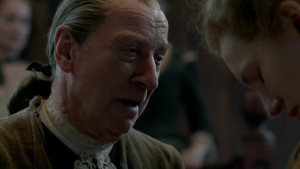
How does syncretism relate to the witch trial? Robena Donaldson accuses Claire of killing her baby. Claire’s interference did not allow the fairies to bring back the true baby. Logically, this is nonsense, but the beliefs in fairies and changelings are engrained in the village people to the point that they make sense to them. Of course, the real person to blame is Robena herself and not Claire. First she should not believe in fairies at all since the church prohibits it. However, the village priest, Father Bain, is not an educated priest. He is not like the cultured priests that Claire meets later on in France. Even Jamie mentions in a previous episode that the villagers have never left Cranesmuir and all the knowledge they have is from Father Bain.
Another aspect to consider is that people at that time wanted something to happen regardless of evidence. They would do everything to change the evidence in favour of the accused to their own purposes. Father Bain mentions in his testimony that he is not a man worthy of God because he failed in saving Thomas Baxter, something that Claire did. In a way, he acknowledges Claire’s abilities and regrets rebuking her. He also adds that he not only failed Thomas Baxter, but also his parishioners and God. It seems that he is trying to put Claire in a good position. However, a man from the audience comments that she should get burned from driving a man of God away from his duties. Basically evidence in favour of is turned into evidence against the accused.
Women with power were not seen in a good way. In the case of Geillis, as the widow of Arthur Duncan, it is likely that she inherited his property and money after his death. Even though she is not an English sassenach like Claire, she is also an “outsider” in a way. Although she is from the Scottish Highlands, the people from Cranesmuir do not know her. Furthermore, she is a stranger who acquired a bad reputation with her fabrications of potions and charms. There is a witness in the trial who accuses her of changing nature and flying. This man and Geillis’ maid were more likely paid to testify. Is Colum behind this? In the case of Claire, her power lies on being a healer, and it seems that this was not viewed positively by the villagers. Father Bain can possibly be blamed for this. Is he a villain or a good guy in the trial? The answer to this question varies among fans so it is more of a personal opinion. My guess is that he probably spoke against her behind her back after the Thomas Baxter incident. However, after knowing that she was being accused of witchcraft, he probably changed his mind but at that time it was too late to fix things.
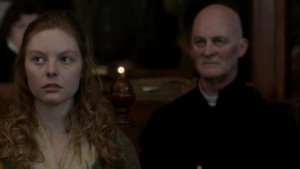
When Laoghaire testifies against Claire, she mentions the “charm” given to her. This association of Claire with charms is what really makes Laoghaire’s accusation legit in front of the audience. Charms are some of the things that Claire should have avoided. She could have lied by saying to the people at Castle Leoch that she learned her healing skills from her husband who was a doctor. She could have said that she is not a charmer, and that she does not believe in charms at all when Laoghaire requested one from her. Of course, she was in a rush trying to escape Castle Leoch and she never thought that she was going to end up marrying Jamie, the main reason why Laoghaire set her a trap. Once Claire is found guilty of witchcraft and condemned to be burned, Laoghaire says to Claire that she will dance upon her ashes. After this episode, TV viewers who have not read the books started to hate her. I would have loved to see Laoghaire’s reaction to Jamie rescuing Claire.
Here is a detailed description of what I consider episode highlights. They are not in order though but I assume my readers have watched this episode.
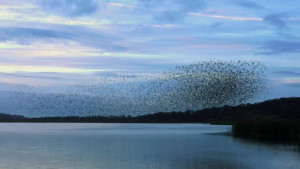
The flock of starlings / the murmuration at the beginning of the episode: This scene is a foreshadowing device for a conversation between Geillis and Claire in regards to a starling. Is this scene at the beginning something that Claire remembers from her past life? Basically the starlings fly in big numbers to keep themselves safe. Does this apply to Geillis and Claire? My personal answer is “yes,” and I also include Ned Gowan in this flock. Ned tried to convince Claire to testify against Geillis to save herself. However, Claire refuses to do that because it is something that does not agree with her moral values, and in a way she is protecting Geillis even though that means their doom. Before Claire is taken to be lashed, Ned Gowan withdraws his gun to protect her. Finally, Geillis protects Claire by doing exactly what Ned wanted Claire to do and claims her innocence. I have not heard the producer’s podcast in regards to this but this is my personal take on this. The single starling that Claire sees from the thief’s hole might signify that they are alone at the beginning of the trial. There is a voiceover in which Claire does not see a familiar face at the trial.
Geillis as a time traveller: There was some foreshadowing to Geillis being a time-traveller in episode 10’s dancing scene. While being in the thief’s hole, Geillis questions Claire whether she was there to change the past. The viewer learns that Geillis suspects Claire to be a time-traveller, something that is revealed later on in Drums of Autumn. When Roger MacKenzie reads Geillis’ grimoire, the name of Claire Randall is written under the list of people who disappeared at the stones. This scene also reveals that both Dougal and Colum have suspicions about Claire’s sudden presence among them out of nowhere. Basically Geillis is willing to die as a witch for the Jacobite cause as long as it succeeds. Claire confesses that her presence is accidental. Later on Geillis tells Claire during their break that it is possible to go back, and gives her the year in which she travelled to the past, “1968,” before they are separated at the trial. How did Geillis acquire so much information about time-travelling. In subsequent books other time-travellers who use gemstones for protection when going through the stones are revealed. Geillis is aware of the protection that gemstones offer and she actually collects them. These time-travellers do mention a particular name, Raymond, a character that is very likely Claire’s friend in Dragonfly in Amber.

The defense lawyer: The appearance of Ned Gowan to defend the accused was nicely done, especially with the emphasis on the Scottish law. There is no doubt viewers loved how he changed the arguments against Claire by accusing Geillis’ maid of being not happy at her current position and by making Mrs. Donaldson realize that it was her fault that her baby is not with her. At certain point, Claire asks Ned whether Colum sent him. He answers “no” hesitantly. Does Colum want to get rid of Claire or is he just simply avoiding the villagers? The answer to this question is open to speculation at this stage. However, the viewer knows from episode 109 that he is not pleased with Jamie marrying a sassenach.
The affair between Geillis and Dougal: Geillis confirms that Dougal is a womanizer – he likes the “lasses” and that their relationship shares only one common denominator: the Jacobite cause. Therefore their relationship is more political in nature and there is no love between them.
Claire screaming at the crowd: Caitriona excelled in this scene. After Ned Gowan is violently taken by the crowd, Claire starts screaming to the audience that they will burn in hell. This speech is intimidating and produces a negative effect on the audience. Everybody is scared.
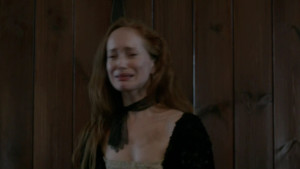
The lashing of Claire: This was a painful scene to see. When Claire is being lashed, there is a lot of emotion in Geillis’ face, and she starts to cry. There are also other horrified ladies in the audience.
Prince Charming rescues the damsel in distress: When Jamie appears to rescue Claire, it seems that Geillis realizes that there is true love between Jamie and Claire, and she feels sorry for everything that has happened to Claire, an innocent person who considered her a friend. At this moment, the viewer feels bad about Geillis. She was hoping for Dougal to come and rescue her, something that did not happen. This shows the lack of love in their relationship. I felt bad about Geillis when reading this event in the books. It would have been nice for Dougal to appear to save his child at least at this critical time.
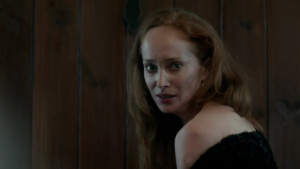
Geillis’ confession: To protect Claire, she does something similar to what Ned Gowan was expecting Claire to do. She claims that Claire is innocent and takes all the blame. She exposes her vaccination scar confessing that it is the mark of the devil but at the same time revealing to Claire that she is from the future too. The way how Lotte did this was great. What a fine actress!
Claire’s revelation to Jamie: Since Claire carries the Devil’s Mark, Jamie wants to know whether she is a witch or not. She then reveals that she is from the future. At first, he believes her because he trusts her. In the books, Claire’s face reveals her as a poor liar. Obviously Jamie knows she is not lying. Further conversation reveals that she is telling the truth, especially when Jamie realizes that he unjustly spanked her for disobeying him when what she really wanted was to go back to her time. Jamie takes Claire to the stones perceiving that she is not interested in remaining with him. The voiceover makes it clear that he was talking to her about Lallybroch but her mind went adrift. Jamie sending Claire back is a sign of love. He wants her to be happy and safe regardless of him being unhappy. However, she makes the decision to stay with him because of love.
